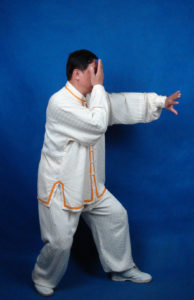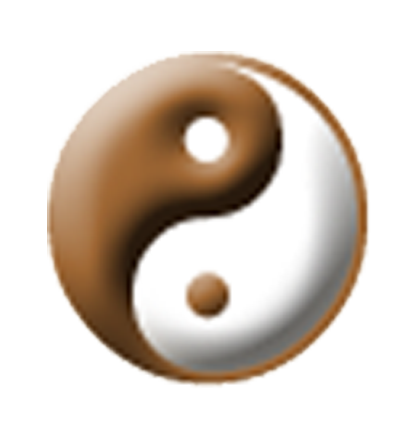09. Hands Strum the Lute
Practice Method and Details
The following is from our book on Wudang Qigong, originally published in 1999. Photos of Professor Liu here are from 2006.

Set 9 Pipa Exercise
Three times play the pipa[1] on each side,
yin and yang changing within is natural.
Intention and breath are monarchs; the bones and flesh are subjects,
Heaven’s energy and earth’s intelligence nourish the golden pill.
1) Preparation
The movement method is exactly the same as for Extreme Emptiness Exercise, Preparation Postures. (see Illustrations 1-1, 1-2, 1-3, 1-4)
2) Regulate the Breath Up and Down
The previous movement pauses slightly. After regulating the breath out and in two times, both legs extend and straighten, naturally standing erect. At the same time, both arms revolve to the outside; both hands follow this turning inward and rising upward, the heels of the palms stop just below both breasts. The fingertips of both hands face front, the palms face up. At the same time as this, the dan tian sinks inward, breathe in. The tongue pushes against the upper palate, the teeth are slightly closed, the eyes look toward the front. (Illustrations 9-1 and 9-2)
The previous movement does not stop, the body’s center of gravity lowers, both legs bend at the knees and squat down. Squat down, changing into a horse stance. At the same time, both arms revolve inward and both elbows are closed as if carrying something. The hands turn toward the front of the body in an arc shape and press down, stopping at the front of the abdomen. The palms face down, the fingertips face forward. At the same time, the dan tian sticks outward, breathe out. The tongue moves toward the lower palate; the teeth are lightly closed. The eyes look slightly downward; the mind is at the dan tian; the breath circulates through both the Du Mai and the Ren Mai. (Illustration 9-3)
3) Pipa Left Posture
The previous movement pauses slightly, the body’s center of gravity moves to the right, the body turns toward the left moving 90 degrees, the left toes raise upward changing to a left high empty stance. At the same time, both hands with vertical palms face left extending left and up. the left palm slightly higher than the shoulder, the fingertips point front, the palm faces right; the right palm stops at the inside of the left elbow joint, the fingertips point up, the palm faces left. At the same time as this, the dan tian turns inward and sinks in, breathe in. The tongue pushes against the upper palate; the teeth are slightly closed. The eyes follow the motion of the left hand’s fingers; the intention is at the crown of the head the Bai Hui acupuncture point. (Illustration 9-4)
The previous movement does not stop, the body turns slightly toward the left, the left arm revolves outward, the left palm circles back and turns, the fingertips face up, the center of the palm Lao Gong acupuncture point is in front of the left side Si Bai acupuncture point; the right arm revolves inward, the right palm fingers use strength in turning outward to pluck and play,[1] the fingertips face left, the palm faces front. (Illustration 9-5)
Following closely behind the previous movement, the body turns slightly toward the right, the right arm revolves outward, the right palm circles back and turns, the fingertips face up, the center of the palm Lao Gong acupuncture point is in front of the right side Si Bai acupuncture point; the left arm revolves inward; the fingers of the left palm use strength in turning outward to pluck and play, the fingertips face right, the center of the palm faces front. At the same time as this, the dan tian sticks outward, gradually breathe out. The tongue is close to the lower palate, the teeth are lightly closed. The eyes follow the movement of the hands, the intention is on the Lao Gong acupuncture point facing the Si Bai extending warm breath. (Illustration 9-6)
4) Turn Right, Connect the Breath
The previous movement pauses slightly, the body turns to the right 90 degrees. After regulating the breathing in and out two times, both legs extend and straighten, naturally standing erect. At the same time, both arms revolve outward, both hands follow this turning inward and raising upward, the heels of the palms stop just below both breasts. The fingertips point to the front, the palms face up. At the same time as this, the dan tian sinks inward, when breathing in the tongue pushes against the upper palate, the teeth are slightly closed; the eyes look toward the front. (Illustration 9-7)
The previous movement does not stop, the body’s center of gravity lowers, both legs bend at the knees squatting down, changing into a horse stance. At the same time, both arms revolve inward and both elbows are closed as if carrying something. The hands turn toward the front of the body in an arc shape and press down, stopping at the front of the abdomen. The palms face down, the fingertips face forward. At the same time, the dan tian sticks outward, breathe out. The tongue is close to the lower palate, the teeth are lightly closed, the eyes look slightly downward, the intention is on the dan tian; breath circulating through both the Du Mai and the Ren Mai. (Illustration 9-8)
5) Pipa Right Posture
The movement methods are entirely the same as for Pipa Left posture, but the left and right sides are reversed (see Illustrations 9-4, 9-5, and 9-6).
6) Turn the Body, Return to the Beginning
The movement methods are entirely the same as for Pushing the Mountain Extremely Empty Initially (see Illustration 2-1). The previous movement does not stop, the movement methods are entirely the same as for Extreme Emptiness Exercise, Blend the Elements with One Breath (see Illustration 1-8).
Main Points and Functions
In practicing Pipa Skill, the major point is to nourish the kidneys and strengthen the kidneys. The kidneys rule the bones; the bones can create marrow, thus “the brain is the sea of marrow.” So then, when kidney energy is abundant, naturally vigor will be plentiful, thoughts quick, memory stronger, and muscles and bone tougher.
The movement methods in this exercise should be fully comfortable, relaxed, and soft, and in addition must unfold elegantly and with composure. In relation to a relaxed situation, the whole body muscles, joints, bone, blood vessels all must expand and contract. One after another, hard and soft must come into accord, the whole body the entire form becomes one whole body, joined together harmoniously, within motion is stillness; within stillness is motion.
In practicing Pipa Skill, one also needs to pay attention to avoiding the “three tensions” namely, shape of the body tension, thought tension, and breathing tension. When the body is naturally relaxed, then it cannot be stiff and inflexible, nor can it be weak and without strength, to achieve relaxed but not slack, the whole form having one kind of inner breath force.
The thoughts must be alert, neither continuing nor ceasing, appearing to observe yet not observing, intention without expecting without helping, without effort or striving. The respiration should be natural, leisurely, slow and continuous, cannot hold back the breath, and furthermore cannot strive for strength, this is certain. These three points must be understood thoroughly to achieve a practice in which the whole undergoes a process of regulation. The energy and breath must circulate and flow through the main and collateral channels in the whole body, and together with the movement secretly combine. When breathing out, pluck the strings, when breathing in turn around. After each time the breath circulates in the movement, one must also return to emptiness, enter into nothing returning the workmanship to the lower dan tian Qi Hai acupuncture point is the requirement.
In this way, over a long period, with painstaking practice, the inner Energy and breath move more and more smoothly, the inner Breath moving and turning reaches a more and more advanced level, the breath body treats the person’s body having very great effects. When the Breath gathers, then there is life, when the breath is scattered, there is death. If a person wants a long life, they must take good care of the Breath , respect the personal aura, and lay stress on the Energy (Earlier Heaven Energy and Later Heaven Energy ). When the Energy , Breath , and Spirit are sufficient, then one can achieve a countenance with dazzling brightness, ears with acute hearing and eyes bright, full of vigor, a radiant Spirit.
Practice Method:
Each time, practice 6 times or 12 times to make one set. Practicing again and again in succession is fine. The size of the movements, large or small, high or low is not restricted, but depends on the age or youth, the extent of physical strength, and the strength or weakness in the physique of the one who is practicing.
[1] 弹拨 tanbo – to pluck or strike; to play a musical instrument. The pipa is played by plucking its strings.
[1] 琵琶 pipa – a Chinese stringed musical instrument similar to the English lute.
09/16/2022 Terri Morgan
